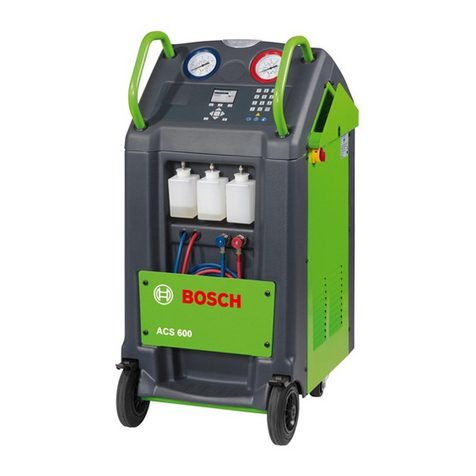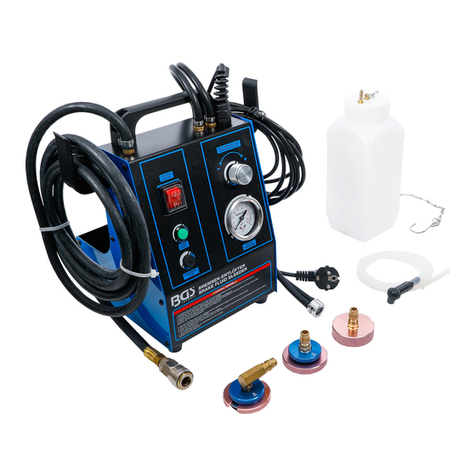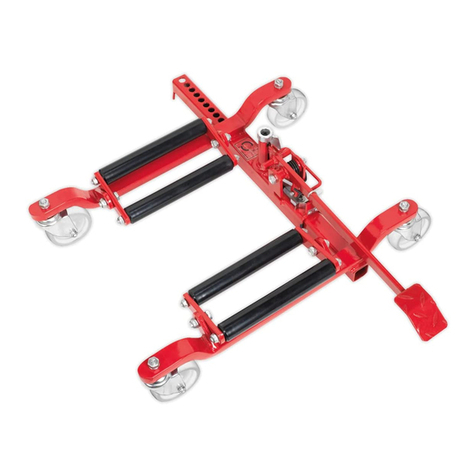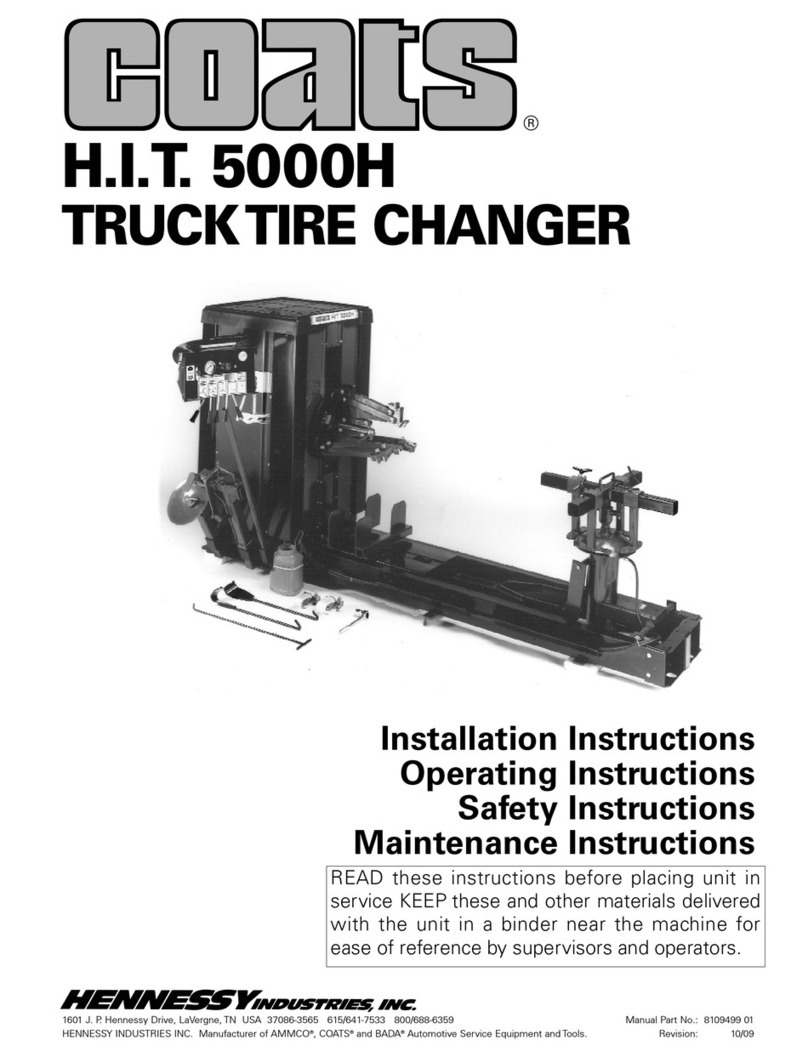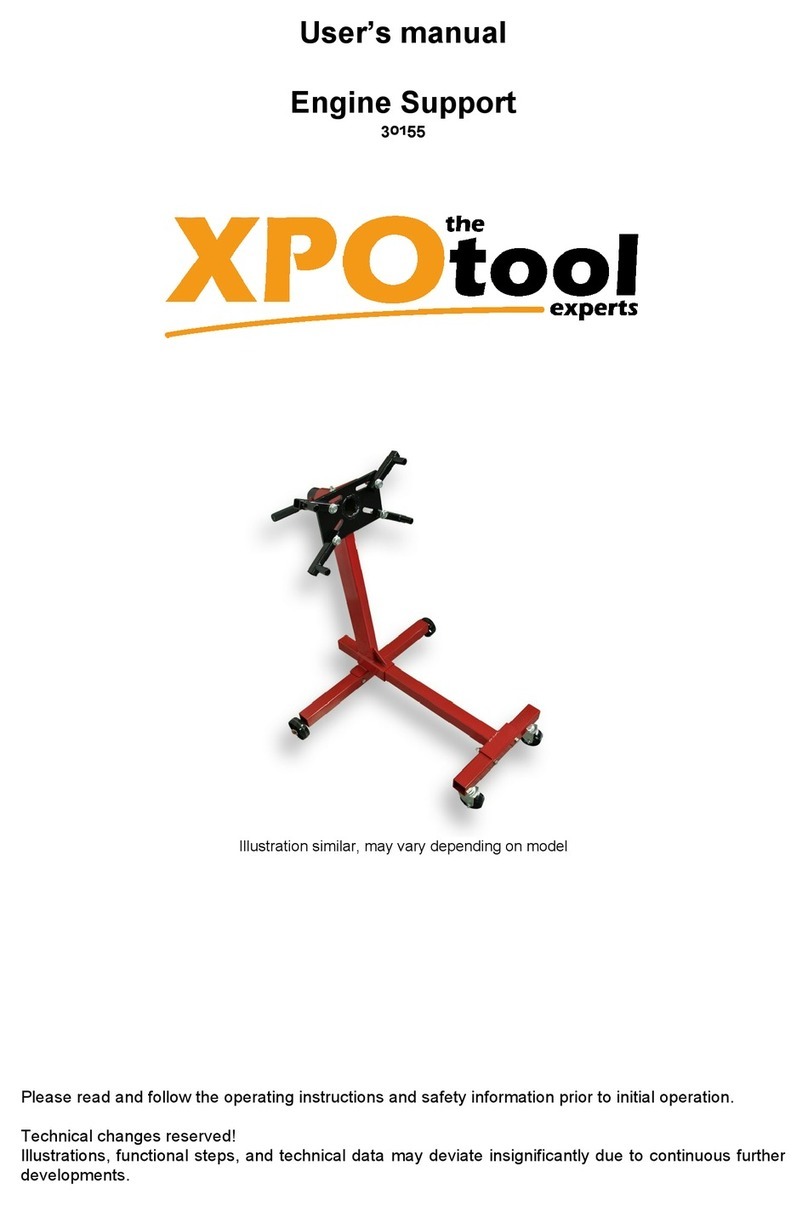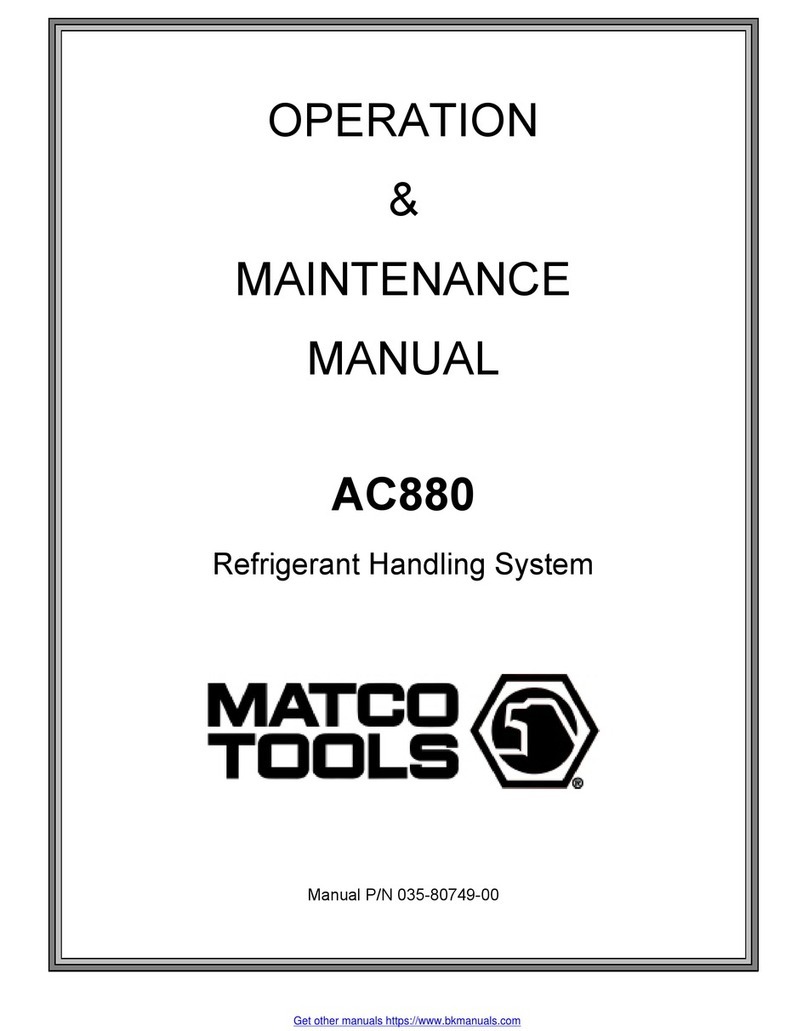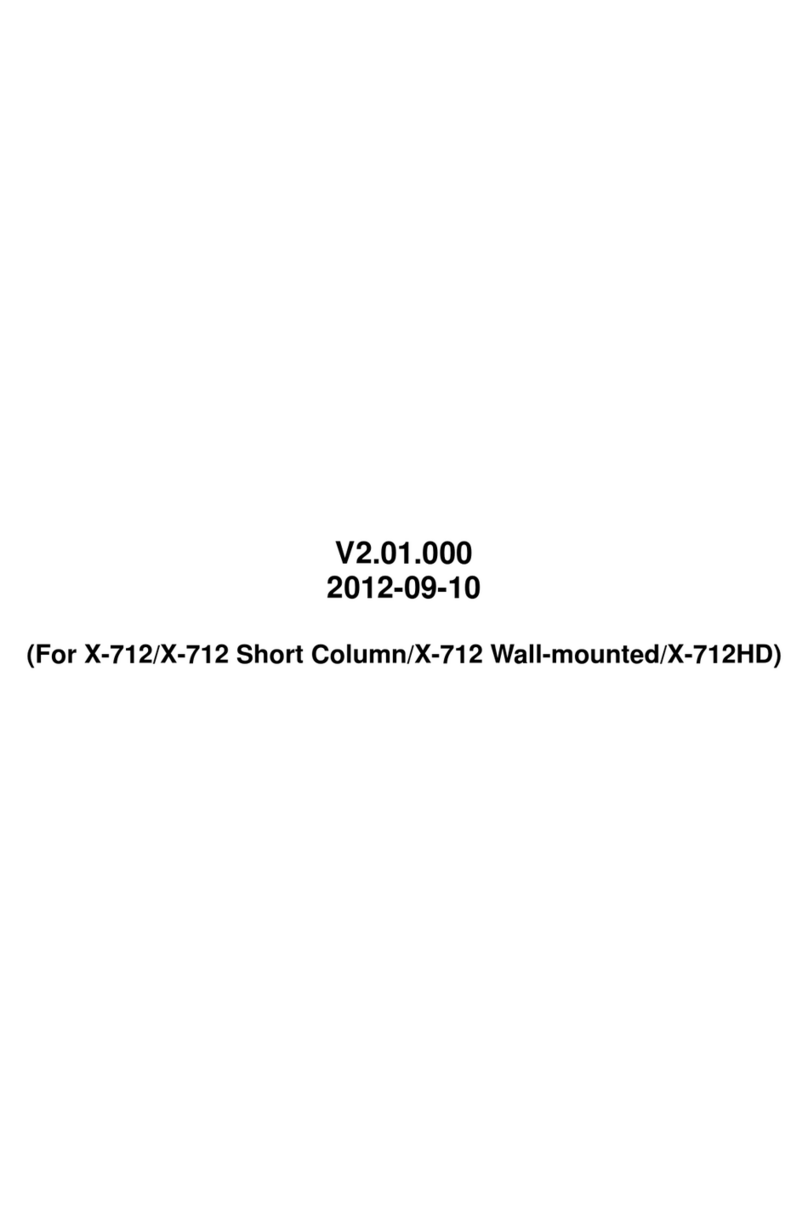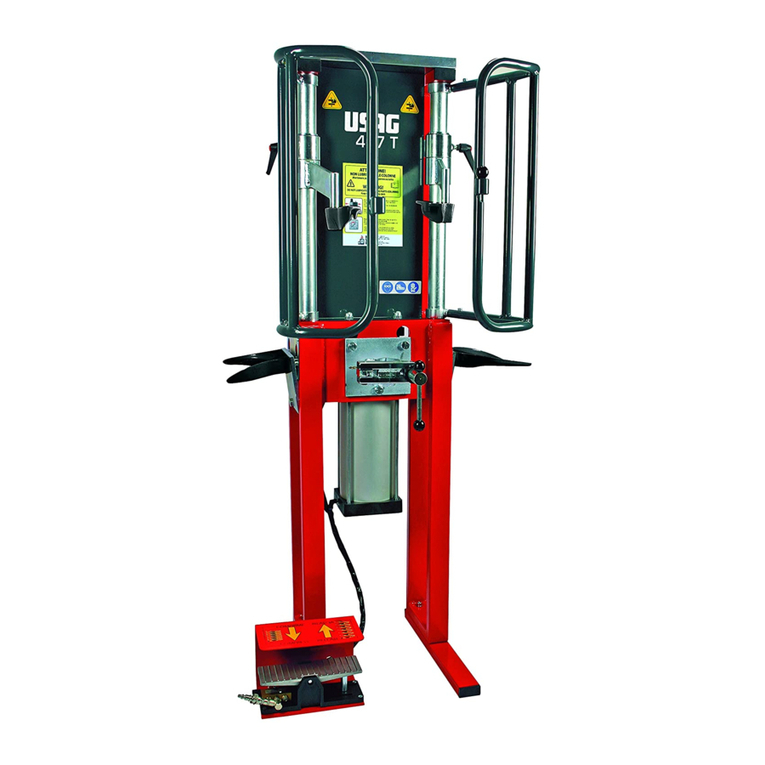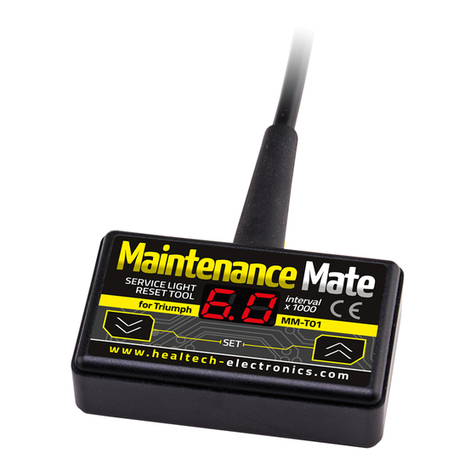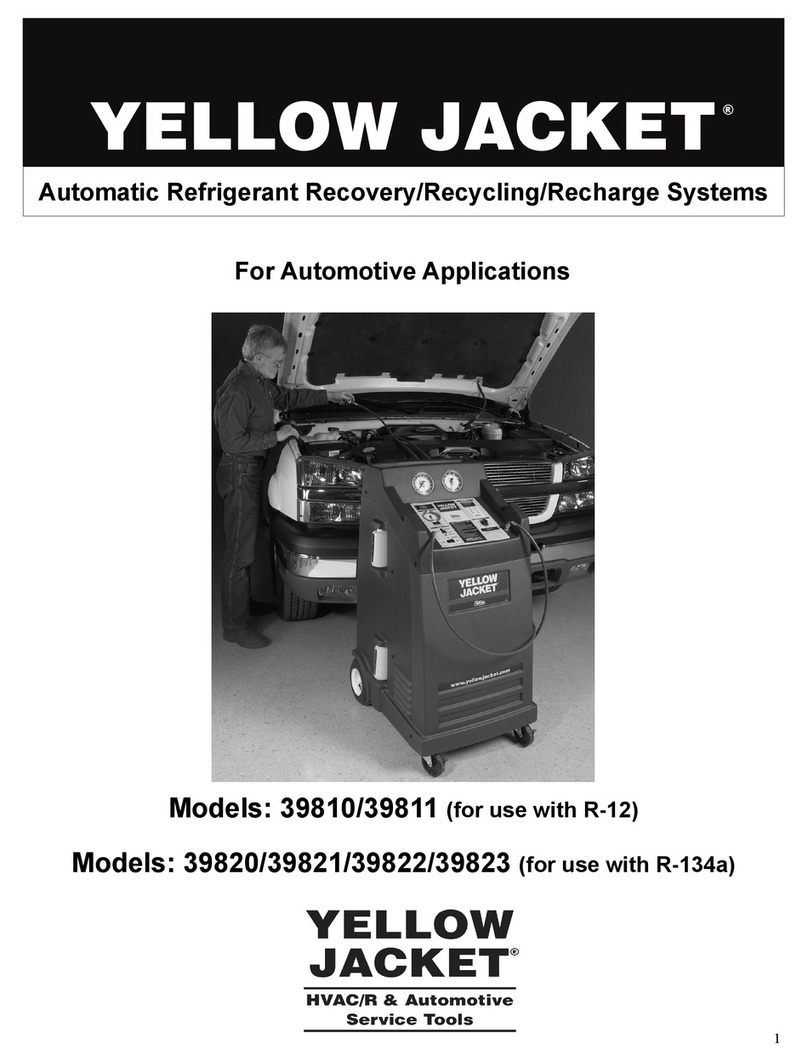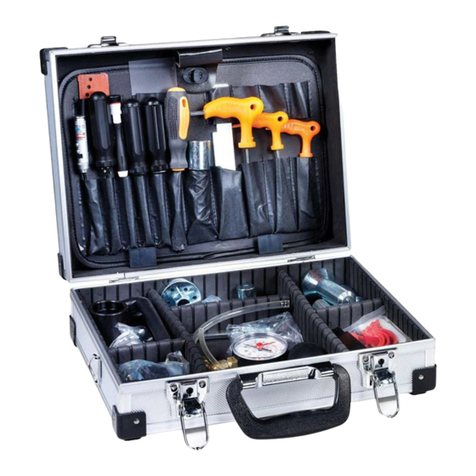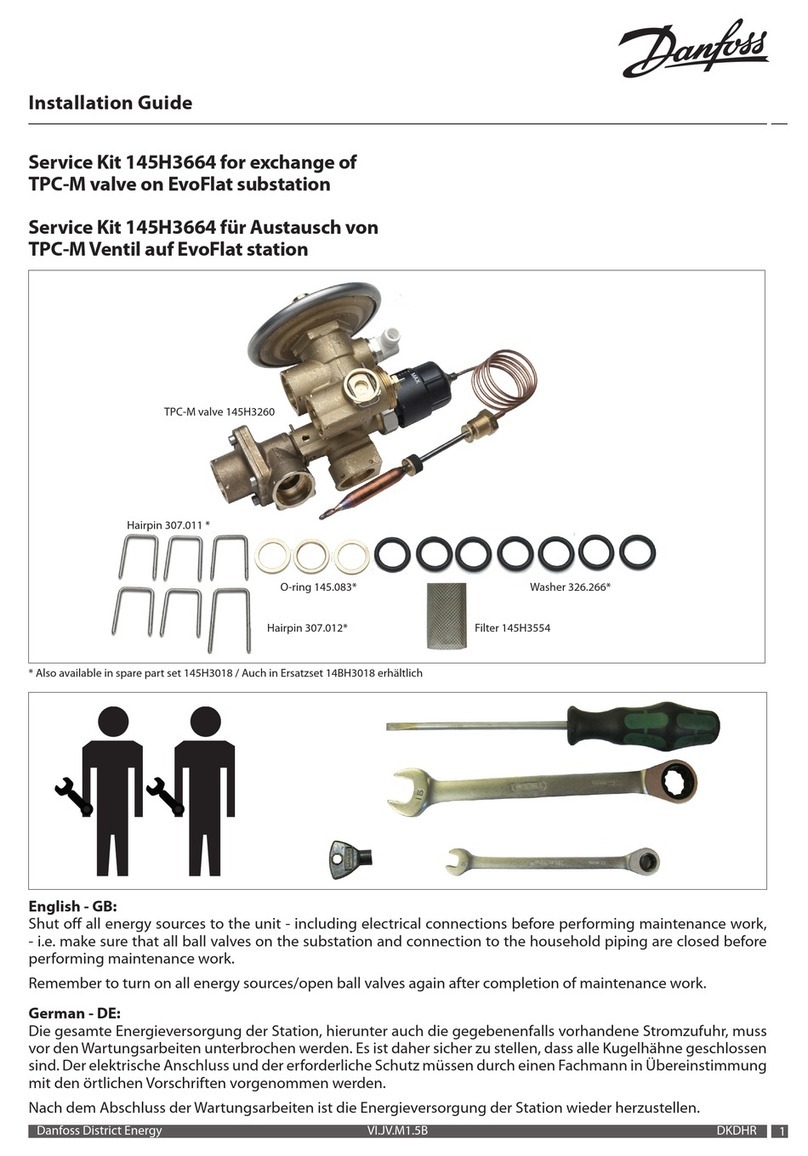Bosch ACS 810 Setup guide

ACS 810
A/C service unit
en
Repair instructions
A/C service unit

| 2 | ACS 810 |en
1 689 975 253 2021-01-26| Robert Bosch GmbH
en – Contents
1. Symbols used 3
1.1 In the documentation 3
1.1.1 Warning notices - Structure and
meaning 3
1.1.2 Symbols in this documentation 3
1.2 On the product 3
2. Important information 4
3. Test equipment and auxiliary materials 4
4. Safety regulations 5
4.1 Handling refrigerant R134a 5
4.2 Working on the vehicle 5
4.3 Notes on operation 6
4.4 Maintenance work 6
4.5 Safety devices 6
4.6 PED directive 2014/68/EU 6
5. Product description 7
5.1 Description of unit 7
5.1.1 Front view 7
5.1.2 Rear view 7
5.1.3 Display and control panel 8
5.1.4 Selection and function keys 8
5.1.5 Input keys 8
6. Program structure 9
6.1 Calibration and tare 9
6.2 Settings 9
6.3 Repair 9
6.4 Vehicle and customer data 9
6.5 Menu 9
6.6 Manual mode 9
6.7 Automatic mode 9
6.8 Flush (optional) 9
6.9 Enter 9
7. Hydraulics diagram 10
8. Service phases 11
8.1 Recovery 11
8.2 Draining oil into the used oil bottle 13
8.3 Vacuum phase 14
8.4 Leak test 16
8.5 Refrigerant preparation 17
8.6 Fresh oil filling 18
8.7 Filling refrigerant 19
8.8 Separating and returning compressor oil 20
8.9 Non-condensing gases 21
9. Troubleshooting 22
9.1 Service messages 22
9.2 Fault messages 22
10. Emptying the ACS 810 23
10.1 Automatic emptying 23
10.2 Extraction of internal refrigerant circuit with
second A/C service unit 23
11. TROUBLESHOOTING AND ANALYSIS 24
11.1 Faults during recovery 24
11.1.1 Compressor starts 24
11.1.2 Compressor does not start 24
11.1.3 Fault messages that can occur during
recovery 25
11.1.4 Other fault messages 25
11.2 Faults during the vacuum phase 25
11.2.1 The vacuum pump starts 25
11.2.2 The vacuum pump does not start 25
11.2.3 Fault message that can occur during the
vacuum phase 26
11.3 Faults during refrigerant preparation 26
11.4 Non-condensing gases are not drained 26
11.5 Faults during filling with refrigerant 26
11.5.1 Vehicle air conditioning system cannot
be filled 26
11.5.2 Other fault messages 26
12. Component test and maintenance 27
12.1 Vacuum pump 27
12.2 Pressure sensor P1 27
12.3 Pressure switch P2 27
12.4 Expansion valve 27
12.5 Periodic check of the non-condensable gas
purge valve 28
12.6 Combo filter 28
12.6.1 Replacement of combo filter 28
12.6.2 Reset filter 29
12.7 Vacuum pump 30
12.7.1 Changing vacuum pump oil 30
12.7.2 Reset of oil change interval 30

Symbols used | ACS 810 | 3 | en
1 689 975 253 2021-01-26|Robert Bosch GmbH
1. Symbols used
1.1 In the documentation
1.1.1 Warning notices - Structure and meaning
Warning notices warn of dangers to the user or
people in the vicinity. Warning notices also indicate
the consequences of the hazard as well as preventive
action. Warning notices have the following structure:
Warning
symbol
KEY WORD – Nature and source of hazard!
Consequences of hazard in the event of
failure to observe action and information
given.
¶Hazard prevention action and
information.
The key word indicates the likelihood of occurrence
and the severity of the hazard in the event of non-
observance:
Key word Probability of
occurrence
Severity of danger if
instructions not observed
DANGER Immediate
impending danger
Death or severe injury
WARNING Possible impending
danger
Death or severe injury
CAUTION Possible dangerous
situation
Minor injury
1.1.2 Symbols in this documentation
Symbol Designation Explanation
!Attention Warns about possible property
damage.
iInformation Practical hints and other
useful information.
1.
2.
Multi-step
operation
Instruction consisting of several
steps.
eOne-step
operation
Instruction consisting of one step.
Intermediate
result
An instruction produces a visible
intermediate result.
"Final result There is a visible final result on
completion of the instruction.
1.2 On the product
!Observe all warning notices on products and
ensure they remain legible.
¶Wear safety goggles.
¶Wear protective gloves.
¶Protect against dampness and moisture.
13. Calibration 31
13.1 Internal refrigerant cylinder scale 31
13.2 Tara values 31
13.3 Pressure sensor 32
13.3.1 Checking the adjustment 32
13.3.2 Adjusting the pressure sensor 32
14. Component test 33
14.1 LCD 33
14.2 Outputs 33
14.3 Control PCB input signal 33
14.4 Printer 33
14.5 Counter 34
14.6 Service printout 34
14.7 Draining oil 34
15. Changing basic settings 35
16. Software 36
16.1 Vehicle database 36
16.2 Data backup 36
16.3 Software update 36
16.4 Loading a data backup 36
17. Circuit diagram 37
17.1 Control PCB 37
17.2 Computer printed circuit board 38

| 4 | ACS 810 | Important informationen
1 689 975 253 2021-01-26| Robert Bosch GmbH
2. Important information
Installation and/or repairs must only be performed
by trained and instructed Bosch customer service
representatives or companies authorized by Bosch
If the units are opened or modified by unauthorized
persons, any warranty claims become void.
Electrical systems and devices must only be put into
operation when in proper operating condition (details
can be found in the EDIS-Info 200108_084). This
requirement is met if following modification or repair
(initial testing) it is ensured that the requirements
of the electrical engineering directives were adhered
to. To check this, tests should be performed, the
nature and extent of which are based on the measures
specified in the electrical engineering directives (e.g.
in Germany DGUV Vorschrift3). The type and extent
of the tests are described in VDE0701/0702Part1
within Germany. The relevant national directives must
be complied with.
3. Test equipment and
auxiliary materials
RGeneral tools for electricians and A/C mechanics
RDigital multimeter (e.g. MMD 003)
RLoctite 542 (for thread seal) and 222 (for thread
lock)
RCleaning agent (e.g. brake cleaner)
RCalibrating weight 10 - 20 kg for internal refrigerant
scale
RLeak detector (1 689 100 057)
RSimulator (optional)

Safety regulations | ACS 810 | 5 | en
1 689 975 253 2021-01-26|Robert Bosch GmbH
4. Safety regulations
!Always carefully read and observe all the safety
regulations before using the Bosch product.
¶Wear safety goggles.
¶Wear safety gloves.
4.1 Handling refrigerant R134a
Avoid all skin contact with the refrigerant.
The low boiling point of the refrigerant
(approx. -30 °C) can lead to frostbites.
Should it nevertheless come into contact
with the skin, remove any moistened
clothing immediately and rinse the affected
skin with copious amounts of water.
RR134a is colorless, has a weak intrinsic odor and is
heavier than air. It displaces oxygen and may flow into
repair pits. Should refrigerant escape (malfunction),
always ensure adequate ventilation and air extraction
(especially in pits). Exit the workshop.
Never inhale refrigerant and oil vapors.
The vapors can irritate the eyes, nose and
respiratory system. If liquid refrigerant
comes into contact with the eyes, rinse them
thoroughly with water for 15 minutes. Then
obtain medical help even if no pain is felt.
RBefore connecting the ACS 810 to a vehicle air
conditioning system or an external refrigerant
cylinder, make sure the quick-release couplings are
not leaking.
ROnly ever use external refrigerant cylinders
provided with safety valves and certified in line
with the applicable standards.
RBefore switching off the ACS 810, make sure
all filling and drainage operations have been
completed. This prevents refrigerant escaping into
the environment.
Do not use compressed air with R134a.
Some air mixtures with R134a are highly
flammable. Such mixtures are a potential
hazard and may lead to fire or explosions
and thus cause damage or injury.
RRefrigerant extracted from a vehicle air conditioning
system may be contaminated with moisture, lubricant,
dirt and traces of other gases.
RR134a is not to be used in areas in which there
is a danger of explosion. Fire, naked flames and
smoking are prohibited. Welding and soldering are
not permitted.
RHigh temperatures and UV radiation may chemically
separate the R134a. The resultant products cause
coughing and nausea.
RR134a is not to be mixed with other refrigerants.
The mixing of refrigerants can damage the vehicle
air conditioning system.
4.2 Working on the vehicle
If high-voltage components or high-voltage
wires are inexpertly handled, there is a risk of
fatal injury from high voltages and the possible
transmission of current through the body.
RDe-energization is only to be performed by a qualified
electrician, a qualified electrician for specific tasks
(hybrid), or a power systems engineer.
RWork on vehicles with high-voltage components
is only ever to be performed in a safe, de-
energized condition by persons with the minimum
qualification "Trained to perform electrical work".
REven after deactivating the high-voltage vehicle
electrical system, the high-voltage battery may still
be live.
RThe operating condition cannot be established
from any running noise, as the electric machine is
silent when stationary.
RIn gear positions "P" and "N" the engine or electric
motor may start spontaneously depending on the
charge of the high-voltage battery.
RNever open or damage high-voltage batteries.
ROn accident vehicles, never touch high-voltage
components or exposed high-voltage wires before
deactivating the high-voltage vehicle electrical system.

| 6 | ACS 810 | Safety regulationsen
1 689 975 253 2021-01-26| Robert Bosch GmbH
4.3 Notes on operation
!Observe the pertinent legal regulations or
directives to ensure safe handling of pressurized
devices.
RThe ACS 810 must be operated in an environment
corresponding to the directive BGR 157 with
respect to the exchange of air.
RObserve local laws or directives so as to ensure the
safety of the pressurized device. The ACS 810 must
be constantly monitored when in operation. Never
leave the ACS 810 unattended when in operation.
RPosition the ACS 810 on all four wheels on a flat,
vibration-proof surface such that proper operation
of the scales is guaranteed.
RThe ACS 810 can be secured in position by locking
the brake.
RThe ACS 810 must always be transported in its
operating position. Never lay the ACS 810 on its
side, as oil could then escape from the vacuum
pump, or the built-in compressor could be
damaged.
RThere are no additional safety systems for
protecting the ACS 810 against damage resulting
from natural catastrophes.
RACS 810 must be connected to a properly
grounded electrical connection.
RThe vehicle A/C service using the ACS 810 must be
prepared and implemented such that the vehicle
air conditioning system circuit does not have to be
opened (for example by removing the radiator or
engine).
RNever remove any components from inside
the ACS 810 except for maintenance or repair
purposes.
RIf damage to the ACS 810 is established, terminate
usage immediately and contact customer service.
RThe service hoses and quick-release couplings
must be regularly checked for wear and replaced if
damaged.
4.4 Maintenance work
RNever perform any maintenance work which is not
expressly recommended in this manual. Contact
customer service if components have to be
replaced other than in the course of maintenance
work.
RWe recommend calibrating the internal refrigerant
scales at least once per year. Please contact
customer service.
4.5 Safety devices
!For safety reasons it is advisable to use a residual
current operated circuit breaker (rccb) with the
following specifications:
Parameters Specification
Rated voltage 230 VAC ± 10 %
Rated frequency 50 Hz
Rated current 230 VAC 10 A
Rated tripping current 30 mA
Tripping switch C
Overview of safety devices:
Description Operation
Pressure switch Switches the compressor off if the normal
operating pressure is exceeded.
Safety valve The safety valve opens if the design
pressure is exceeded.
Fuse Interrupts the power supply to ACS 810 in
the event of too high current.
Vents The ACS 810 is provided with vents in
the bottom of the housing to ensure the
exchange of air even when switched off.
WARNING: Warranty is not valid in all
cases of improper use of the machine and
if the machine is not submitted to periodic
ordinary and extraordinary maintenance
(according to PED directive 2014/68/
EU) provided in this original instructions.
The manufacturer therefore declines all
responsibilities for any damage resulting
from not observing all the instructions and
warnings provided to the user regarding
installation, use and maintenance.
4.6 PED directive 2014/68/EU
The machine includes parts subject to PED EU
directive 2014/68/EU, Pressure Equipment Directive.
PED directive regulates all the pressurized part
defining for them categories based on volume-
pressure ratio and based on fluid refrigerant type.
Those parts then have not to be anyhow modified nor
removed. Under the responsibility of the owner, the
machine and parts falling in the scope of PED shall be
checked either during commissioning and periodically
fulfilling local country regulations and norms.
Parts in the scope of PED are:
RTank.
RPressure relieve valve.
RHigh pressure switch.
RRecovery group.
RPiping.
iCall Bosch service center to get technical
specifications for each part listed.

Product description | ACS 810 | 7 | en
1 689 975 253 2021-01-26|Robert Bosch GmbH
5. Product description
5.1 Description of unit
5.1.1 Front view
1
2
3
4
56
7
8
9
10
FV_ACS810
Fig. 1: Front view
1 Valve high pressure (HP)
2 Valve low pressure (LP)
3 Printer
4 Display and control panel
5 Gage low-pressure pressure (LP)
6 Gage high-pressure valve (HP)
7 Pressure gage of internal refrigerant cylinder
8 Fresh oil bottle
9 Used oil bottle
10 Front wheels with locking brake
iThe high (6) and low pressure (5) gages show the
current pressure during the air conditioning service
on the vehicle. The small gage (7) is used to check
the bottle pressure in the internal refrigerant
cylinder.
iThe two valve settings are labeled as follows:
$C (Close) = valve is closed
$O (Open) = valve is open
5.1.2 Rear view
4
1
2
3
4
5
6
7
Fig. 2: Rear view
1 Service quick-release coupling (LP)
2 Service quick-release coupling (HP)
3 Service hose (5 m)
4 Service hose mount
5 Rear wheels
6 Power cord (socket)
7 Master switch

| 8 | ACS 810 | Product descriptionen
1 689 975 253 2021-01-26| Robert Bosch GmbH
5.1.3 Display and control panel
The display and control panel of the operating unit
control the menus and the service phases.
7
8
9
10
1
4
3
2
5
6
Fig. 3: Display and control panel
1 Flushing
2 Automatic service
3 Filling
4 Vacuum
5 Removal by suction
6 LCD display
7 Key panel
8 Vehicle database
9 PS2 interface 1)
10 Function light
1) For updating firmware/software or database
5.1.4 Selection and function keys
Keys Name Operation
Evacuation Refrigerant is extracted from the
vehicle.
RControl up
RVacuum
RUpward cursor movement.
RA vacuum is generated.
RControl
right
RFilling
RCursor movement to the right.
RVehicle air conditioning system
is filled with refrigerant.
RControl
left
RAutomatic
RCursor movement to the left.
RAutomatic service run: Air
conditioning service is carried
out according to saved
parameters.
RControl
down
RFlushing
RDownward cursor movement.
RFlush components of the
vehicle air conditioning.
Menu
Call up various function for
service
and data management.
Database
Call up databases:
RUSER SPECS
RVEHICLE DATAS
Enter (E)Confirm and take over.
Stop Terminate and return.
Various functions are assigned to the <MENU>
function key in the ACS 810 software. The functions of
the keys are defined in the menu line of the ACS 810
software.
5.1.5 Input keys
The input keys can be used to enter letters, numbers
and special characters in the input boxes.

Program structure | ACS 810 | 9 | en
1 689 975 253 2021-01-26|Robert Bosch GmbH
6. Program structure
6.1 Calibration and tare
Input Menu
1. + <3>
2. Enter 1111.
3. Confirm with E.
TANK CALIBRATION
IN OIL CALIBRATION 1)
OUT OIL CALIBRATION 1)
PRES. CALIBRATION
TANK TARE
IN OIL TARE 1)
OUT OIL TARE 1)
6.2 Settings
Input Menu
1. + <3>
2. Enter 2222.
3. Confirm with E.
LANGUAGE
DATE/TIME
UNIT OF MEASURE
HOSES LENGTH
CONTRAST
GARAGE ADDRESS
FLUSHING
OIL SCALE 1)
UV DYE 1)
DATABASE UPDATE
SERIAL NUMBER
EXPERT MODE
6.3 Repair
Input Menu
1. + <3>
2. Enter 5555.
3. Confirm with E.
CHANGE FILTER
CHANGE OIL
6.4 Vehicle and customer data
Input Menu 1 Menu 2
<Database>
STANDARD SPECS EUROPEAN DATABASE
USER SPECS SELECT MODEL :
DELETE MODEL :
ADD MODEL :
VEHICLE DATAS
6.5 Menu
Input Menu 1 Menu 2
<Menu>
PERFORMANCE TESTS
DIAGNOSTIC
TANK FILLING
TANK RECYCLING
ZEROING OIL SCALES 1)
REPORT MANAGEMENT PRINT REPORT
EXPORT DATA
DELETE DATA
6.6 Manual mode
Input Menu
<RECOVERY>
RAutomatic emptying
RExtraction
ROil drain
RPressure test
SELECT PORTS
...
Input Menu
<VACUUM>
SET VACUUM TIME
...
Input Menu
<CHARGE>
SELECT PORTS
...
6.7 Automatic mode
Input Menu
<AUTOMATIC>
SELECT PORTS
...
6.8 Flush (optional)
Input Menu
<FLUSH>
SET VACUUM TIME
...
6.9 Enter
Input Menu
<ENTER>
Information on current filling
capacities of fresh and used
oil bottles and the internal
refrigerant cylinder
1) Not supported for ACS 810 or without functionality

| 10 | ACS 810 | Hydraulics diagramen
1 689 975 253 2021-01-26| Robert Bosch GmbH
7. Hydraulics diagram
M2
HIGH
LOW
P1
T1
T2
EV8
1
2
P
EV1
EV5
EV3
EV6
3F1
C
P2
HP
5
6
F2
9
4
EV7
10
7
V1
8
V3 V2V4
V6V5
M1
M3
EV10
VU1
11
P
Des. Description
1 Fresh oil tank
2 Vacuum pump
3 Expansion valve
4 Evaporator/oil separator
5 Compressor oil separator
6 Compressor
7 Internal refrigerant cylinder
8 Refrigerant cylinder scale
9 Used oil bottle
10 Heat exchanger
11 Refrigerant pump
T1 Low pressure hose
T2 High pressure hose
M1 Low pressure gage
M2 High pressure gage
M3 Internal refrigerant cylinder pressure gage
F1 Coarse filter
Des. Description
F2 Combi filter
VU1 Oil non-return valve
EV1 Vacuum solenoid valve
EV3 Flow solenoid valve
EV5 Recovery solenoid valve
EV6 Filling solenoid valve
EV7 Oil drain solenoid valve
EV8 Oil injection solenoid valve
EV10 Refrigerant pump by-pass solenoid valve
P1 Pressure sensor
P2 Pressure switch
V1 Tank vapour side hose valve
V2 Tank liquid side hose valve
V3 Tank vapour side valve
V4 Tank liquid side valve
V5 Safety valve
V6 Non condensable drain valve

Service phases | ACS 810 | 11 | en
1 689 975 253 2021-01-26|Robert Bosch GmbH
8. Service phases
iThis section describes all of the ACS 810 service
phases. In addition, it explains the hydraulic
and electric circuits by presenting the hydraulic
diagram and providing a brief description of the
components involved in each function.
8.1 Recovery
iIn this service phase, the refrigerant is extracted
from the vehicle air conditioning system.
1. The ACS 810 is connected to the vehicle with the
service hoses T1 and T2.
2. Open the service quick-release coupling valves.
The pressure on the high and low pressure side
of the vehicle air conditioning system is indicat-
ed on the pressure gages M1 and M2.
iOpening the HP and LP valves on the ACS 810
causes the refrigerant to flow to the solenoid valves
EV10 (open) and EV3 (closed).
iThe pressure sensor P1 checks the pressure of the
vehicle air conditioning system (whether or not
there is refrigerant in the vehicle air conditioning
system).
3. starts extraction of the refrigerant.
The solenoid valves EV10, EV3 and EV5 are
opened and the compressor (6) is started.
RThe refrigerant flows through the solenoid valves
EV10, EV3 and EV5, the mechanical filter (F1), the
expansion valve (3), and the condenser/separator
(4).
RThe expansion valve maintains a constant pressure
at the evaporator/oil separator (4).
RIn the evaporator/oil separator (4), the oil
extracted from the vehicle air conditioning system
is separated from the refrigerant and routed into
the used oil bottle.
RThe refrigerant then flows on through the combo
filter (F2) and the compressor (6) into the
condenser/separator (5), and finally into the
internal refrigerant cylinder.
iThe combo filter (F2) cleans the extracted
refrigerant of suspended particles and moisture.
iIn the evaporator/oil separator (5), the oil taken
in from the compressor is separated from the
refrigerant and fed back to the compressor.
iIf the pressure at sensor P1 falls below the
value saved in the software, the function stops
automatically, the program waits 5 minutes for a
pressure increase and, if necessary, restarts with a
second recovery cycle.
At the end of this phase, the solenoid valves EV10,
EV3 and EV5 are closed and the compressor 6 is
turned off.

| 12 | ACS 810 | Service phasesen
1 689 975 253 2021-01-26| Robert Bosch GmbH
Des. Description
1 Fresh oil tank
2 Vacuum pump
3 Expansion valve
4 Evaporator/oil separator
5 Compressor oil separator
6 Compressor
7 Internal refrigerant cylinder
8 Refrigerant cylinder scale
9 Used oil bottle
10 Heat exchanger
11 Refrigerant pump
T1 Low pressure hose
T2 High pressure hose
M1 Low pressure gage
M2 High pressure gage
M3 Internal refrigerant cylinder pressure gage
F1 Coarse filter
Des. Description
F2 Combi filter
VU1 Oil non-return valve
EV1 Vacuum solenoid valve
EV3 Flow solenoid valve
EV5 Recovery solenoid valve
EV6 Filling solenoid valve
EV7 Oil drain solenoid valve
EV8 Oil injection solenoid valve
EV10 Refrigerant pump by-pass solenoid valve
P1 Pressure sensor
P2 Pressure switch
V1 Tank vapour side hose valve
V2 Tank liquid side hose valve
V3 Tank vapour side valve
V4 Tank liquid side valve
V5 Safety valve
V6 Non condensable drain valve
M2
HIGH
LOW
P1
T1
T2
EV8
1
2
P
EV1
EV5
EV3
EV6
3F1
C
P2
HP
5
6
F2
9
4
EV7
10
7
V1
8
V3 V2V4
V6V5
M1
M3
EV10
VU1
11
P

Service phases | ACS 810 | 13 | en
1 689 975 253 2021-01-26|Robert Bosch GmbH
8.2 Draining oil into the used oil bottle
At the end of recovery, the solenoid valve EV7 opens
and the oil previously separated out in the evaporator/
oil separator (4) drains into the used oil bottle (9).
Des. Description
1 Fresh oil tank
2 Vacuum pump
3 Expansion valve
4 Evaporator/oil separator
5 Compressor oil separator
6 Compressor
7 Internal refrigerant cylinder
8 Refrigerant cylinder scale
9 Used oil bottle
10 Heat exchanger
11 Refrigerant pump
T1 Low pressure hose
T2 High pressure hose
M1 Low pressure gage
M2 High pressure gage
M3 Internal refrigerant cylinder pressure gage
F1 Coarse filter
Des. Description
F2 Combi filter
VU1 Oil non-return valve
EV1 Vacuum solenoid valve
EV3 Flow solenoid valve
EV5 Recovery solenoid valve
EV6 Filling solenoid valve
EV7 Oil drain solenoid valve
EV8 Oil injection solenoid valve
EV10 Refrigerant pump by-pass solenoid valve
P1 Pressure sensor
P2 Pressure switch
V1 Tank vapour side hose valve
V2 Tank liquid side hose valve
V3 Tank vapour side valve
V4 Tank liquid side valve
V5 Safety valve
V6 Non condensable drain valve
M2
HIGH
LOW
P1
T1
T2
EV8
1
2
P
EV1
EV5
EV3
EV6
3F1
C
P2
HP
5
6
F2
9
4
EV7
10
7
V1
8
V3 V2V4
V6V5
M1
M3
EV10
VU1
11
P

| 14 | ACS 810 | Service phasesen
1 689 975 253 2021-01-26| Robert Bosch GmbH
8.3 Vacuum phase
iDuring vacuum generation in the vehicle air
conditioning system, the refrigerant is prepared
in the internal refrigerant cylinder to remove the
non-condensing gases before filling and to filter the
refrigerant.
1. The ACS 810 is connected to the vehicle with the
service hoses T1 and T2.
2. Open the service quick-release coupling valves.
The pressure on the high and low pressure side
of the vehicle air conditioning system is indicat-
ed on the pressure gages M1 and M2.
iOpening the HP and LP valves on the ACS 810
causes the refrigerant to flow to the pressure
sensor P1 (solenoid valves EV1, EV3, and EV10
are closed). P1 checks the pressure in the vehicle
air conditioning system (refrigerant present in the
vehicle air conditioning system or not).
iIf the pressure in the vehicle air conditioning
system is below the set value, the vehicle air
conditioning system is empty and the ACS 810
starts vacuum generation.
iIf the pressure is above the set value, there is still
refrigerant in the vehicle air conditioning system,
and it must be extracted before vacuum generation.
3. Press the <Vacuum> key.
EV1 and EV10 are opened
The vacuum pump (2) starts.
iThe vacuum pump generates a maximum vacuum
of 0,033 mbar. This depends on the duration of
vacuum generation.
iThe refrigerant in the internal refrigerant cylinder
is fed through the internal refrigerant circuit and
prepared in each vacuum phase.

Service phases | ACS 810 | 15 | en
1 689 975 253 2021-01-26|Robert Bosch GmbH
Des. Description
1 Fresh oil tank
2 Vacuum pump
3 Expansion valve
4 Evaporator/oil separator
5 Compressor oil separator
6 Compressor
7 Internal refrigerant cylinder
8 Refrigerant cylinder scale
9 Used oil bottle
10 Heat exchanger
11 Refrigerant pump
T1 Low pressure hose
T2 High pressure hose
M1 Low pressure gage
M2 High pressure gage
M3 Internal refrigerant cylinder pressure gage
F1 Coarse filter
Des. Description
F2 Combi filter
VU1 Oil non-return valve
EV1 Vacuum solenoid valve
EV3 Flow solenoid valve
EV5 Recovery solenoid valve
EV6 Filling solenoid valve
EV7 Oil drain solenoid valve
EV8 Oil injection solenoid valve
EV10 Refrigerant pump by-pass solenoid valve
P1 Pressure sensor
P2 Pressure switch
V1 Tank vapour side hose valve
V2 Tank liquid side hose valve
V3 Tank vapour side valve
V4 Tank liquid side valve
V5 Safety valve
V6 Non condensable drain valve
3F1
C
P2
HP
5
6
F2
9
4
EV7
10
7
V1
8
V3 V2V4
V6V5
M2
HIGH
LOW
P1
T1
T2
EV8
1
2
P
EV1
EV5
EV3
EV6
M1
M3
EV10
VU1
11
P

| 16 | ACS 810 | Service phasesen
1 689 975 253 2021-01-26| Robert Bosch GmbH
8.4 Leak test
iThe leak test starts after the vacuum phase.
iThe HP and LP valves are open and all solenoid
valves are closed. After the specified vacuum time
has elapsed, EV1 is closed to perform the leak test.
iIf the pressure at P1 falls below the value saved in
the software during the leak test, an error message
is displayed.
Des. Description
1 Fresh oil tank
2 Vacuum pump
3 Expansion valve
4 Evaporator/oil separator
5 Compressor oil separator
6 Compressor
7 Internal refrigerant cylinder
8 Refrigerant cylinder scale
9 Used oil bottle
10 Heat exchanger
11 Refrigerant pump
T1 Low pressure hose
T2 High pressure hose
M1 Low pressure gage
M2 High pressure gage
M3 Internal refrigerant cylinder pressure gage
F1 Coarse filter
Des. Description
F2 Combi filter
VU1 Oil non-return valve
EV1 Vacuum solenoid valve
EV3 Flow solenoid valve
EV5 Recovery solenoid valve
EV6 Filling solenoid valve
EV7 Oil drain solenoid valve
EV8 Oil injection solenoid valve
EV10 Refrigerant pump by-pass solenoid valve
P1 Pressure sensor
P2 Pressure switch
V1 Tank vapour side hose valve
V2 Tank liquid side hose valve
V3 Tank vapour side valve
V4 Tank liquid side valve
V5 Safety valve
V6 Non condensable drain valve
3F1
C
P2
HP
5
6
F2
9
4
EV7
10
7
V1
8
V3 V2V4
V6V5
M2
HIGH
LOW
P1
T1
T2
EV8
1
2
P
EV1
EV5
EV3
EV6
M1
M3
EV10
VU1
11
P

Service phases | ACS 810 | 17 | en
1 689 975 253 2021-01-26|Robert Bosch GmbH
8.5 Refrigerant preparation
1. Press the <MENU> key.
2. Select <R134a PREPARATION> and confirm with E.
"ACS 810 starts internal preparation of the refrigerant.
"EV5 and EV6 are opened and the compressor (6)
starts.
iIn that way, refrigerant is sucked from internal
refrigerant cylinder (7) and is conveyed through the
filter F1, the expansion valve (3), the Evaporator/ oil
separator (4) until reaching the internal refrigerant
cylinder (7) again, as it happens in the recovery stage.
iInternal preparation of the refrigerant is the same
process that the ACS 810 performs in the recovery
phase to clean the refrigerant recovered from the
vehicle air conditioning system.
Des. Description
1 Fresh oil tank
2 Vacuum pump
3 Expansion valve
4 Evaporator/oil separator
5 Compressor oil separator
6 Compressor
7 Internal refrigerant cylinder
8 Refrigerant cylinder scale
9 Used oil bottle
10 Heat exchanger
11 Refrigerant pump
T1 Low pressure hose
T2 High pressure hose
M1 Low pressure gage
M2 High pressure gage
M3 Internal refrigerant cylinder pressure gage
F1 Coarse filter
Des. Description
F2 Combi filter
VU1 Oil non-return valve
EV1 Vacuum solenoid valve
EV3 Flow solenoid valve
EV5 Recovery solenoid valve
EV6 Filling solenoid valve
EV7 Oil drain solenoid valve
EV8 Oil injection solenoid valve
EV10 Refrigerant pump by-pass solenoid valve
P1 Pressure sensor
P2 Pressure switch
V1 Tank vapour side hose valve
V2 Tank liquid side hose valve
V3 Tank vapour side valve
V4 Tank liquid side valve
V5 Safety valve
V6 Non condensable drain valve
M2
HIGH
LOW
P1
T1
T2
EV8
1
2
P
EV1
EV5
EV3
EV6
3F1
C
P2
HP
5
6
F2
9
4
EV7
10
7
V1
8
V3 V2V4
V6V5
M1
M3
EV10
VU1
11
P

| 18 | ACS 810 | Service phasesen
1 689 975 253 2021-01-26| Robert Bosch GmbH
8.6 Fresh oil filling
iYou can only fill new fresh oil into a vehicle A/C
system, if there is vacuum inside the A/C system.
So you have to start first the vacuum phase.
iAfter evacuating the vehicle A/C system, recovered
oil has to be replaced with new oil. The oil
replenishing occurs by pressure difference.
1. Open valve of service quick coupler T2.
2. Open HP valve.
3. Open solenoid valve EV8.
The pressure difference makes fresh oil in the
graduated bottle be sucked inside the vehicle A/C
system.
iAs buses often have huge quantities of oil (even
more than 1 kg), for the oil replenishing the
refrigerant pump (11) is also used that allows the
replenishing of the hole quantity needed.
4. After filling fresh oil, close solenoid valve EV8 and
switch off the refrigerant pump (11).
Des. Description
1 Fresh oil tank
2 Vacuum pump
3 Expansion valve
4 Evaporator/oil separator
5 Compressor oil separator
6 Compressor
7 Internal refrigerant cylinder
8 Refrigerant cylinder scale
9 Used oil bottle
10 Heat exchanger
11 Refrigerant pump
T1 Low pressure hose
T2 High pressure hose
M1 Low pressure gage
M2 High pressure gage
M3 Internal refrigerant cylinder pressure gage
F1 Coarse filter
Des. Description
F2 Combi filter
VU1 Oil non-return valve
EV1 Vacuum solenoid valve
EV3 Flow solenoid valve
EV5 Recovery solenoid valve
EV6 Filling solenoid valve
EV7 Oil drain solenoid valve
EV8 Oil injection solenoid valve
EV10 Refrigerant pump by-pass solenoid valve
P1 Pressure sensor
P2 Pressure switch
V1 Tank vapour side hose valve
V2 Tank liquid side hose valve
V3 Tank vapour side valve
V4 Tank liquid side valve
V5 Safety valve
V6 Non condensable drain valve
M2
HIGH
LOW
P1
T1
T2
EV8
1
2
P
EV1
EV5
EV3
EV6
3F1
C
P2
HP
5
6
F2
9
4
EV7
10
7
V1
8
V3 V2V4
V6V5
M1
M3
EV10
VU1
11
P

Service phases | ACS 810 | 19 | en
1 689 975 253 2021-01-26|Robert Bosch GmbH
8.7 Filling refrigerant
iThe refrigerant in the internal refrigerant cylinder is
used for filling the vehicle air conditioning system.
iRefrigerant can only be added to a vehicle air
conditioning system under a vacuum. The vacuum
phase must therefore be performed before filling.
1. Press the key .
EV3, EV6 and EV10 are opened.
Refrigerant pump (11) will start.
Refrigerant flows from the internal refrigerant
cylinder through valves V4 and V2, through the
solenoid valves EV3, EV6 and EV10, the HP valve
(when filling on the high pressure side) and
along the service hose T2 into the vehicle air
conditioning system.
2. The filling quantity is checked by the scale (8),
which end the filling process after the quantity
previously entered in the service process.
Des. Description
1 Fresh oil tank
2 Vacuum pump
3 Expansion valve
4 Evaporator/oil separator
5 Compressor oil separator
6 Compressor
7 Internal refrigerant cylinder
8 Refrigerant cylinder scale
9 Used oil bottle
10 Heat exchanger
11 Refrigerant pump
T1 Low pressure hose
T2 High pressure hose
M1 Low pressure gage
M2 High pressure gage
M3 Internal refrigerant cylinder pressure gage
F1 Coarse filter
Des. Description
F2 Combi filter
VU1 Oil non-return valve
EV1 Vacuum solenoid valve
EV3 Flow solenoid valve
EV5 Recovery solenoid valve
EV6 Filling solenoid valve
EV7 Oil drain solenoid valve
EV8 Oil injection solenoid valve
EV10 Refrigerant pump by-pass solenoid valve
P1 Pressure sensor
P2 Pressure switch
V1 Tank vapour side hose valve
V2 Tank liquid side hose valve
V3 Tank vapour side valve
V4 Tank liquid side valve
V5 Safety valve
V6 Non condensable drain valve
M2
HIGH
LOW
P1
T1
T2
EV8
1
2
P
EV1
EV5
EV3
EV6
3F1
C
P2
HP
5
6
F2
9
4
EV7
10
7
V1
8
V3 V2V4
V6V5
M1
M3
EV10
VU1
11
P

| 20 | ACS 810 | Service phasesen
1 689 975 253 2021-01-26| Robert Bosch GmbH
8.8 Separating and returning
compressor oil
iDuring the recovery phase and preparation of the
refrigerant, small quantities of compressor oil get
into the internal circuit.
iThis oil is separated from the refrigerant in the
compressor oil separator (5) and is then fed back
to the compressor (6).
Des. Description
1 Fresh oil tank
2 Vacuum pump
3 Expansion valve
4 Evaporator/oil separator
5 Compressor oil separator
6 Compressor
7 Internal refrigerant cylinder
8 Refrigerant cylinder scale
9 Used oil bottle
10 Heat exchanger
11 Refrigerant pump
T1 Low pressure hose
T2 High pressure hose
M1 Low pressure gage
M2 High pressure gage
M3 Internal refrigerant cylinder pressure gage
F1 Coarse filter
Des. Description
F2 Combi filter
VU1 Oil non-return valve
EV1 Vacuum solenoid valve
EV3 Flow solenoid valve
EV5 Recovery solenoid valve
EV6 Filling solenoid valve
EV7 Oil drain solenoid valve
EV8 Oil injection solenoid valve
EV10 Refrigerant pump by-pass solenoid valve
P1 Pressure sensor
P2 Pressure switch
V1 Tank vapour side hose valve
V2 Tank liquid side hose valve
V3 Tank vapour side valve
V4 Tank liquid side valve
V5 Safety valve
V6 Non condensable drain valve
M2
HIGH
LOW
P1
T1
T2
EV8
1
2
P
EV1
EV5
EV3
EV6
3F1
C
P2
HP
5
6
F2
9
4
EV7
10
7
V1
8
V3 V2V4
V6V5
M1
M3
EV10
VU1
11
P
Other manuals for ACS 810
1
Table of contents
Other Bosch Service Equipment manuals
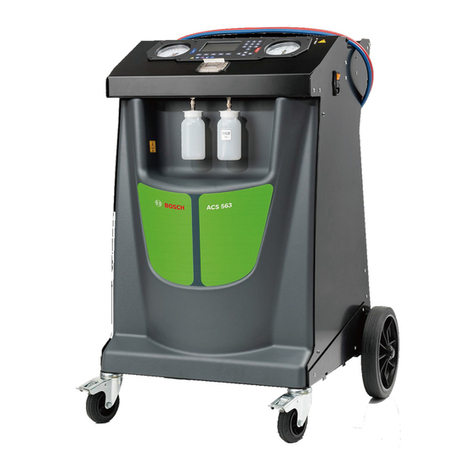
Bosch
Bosch ACS 553 User manual
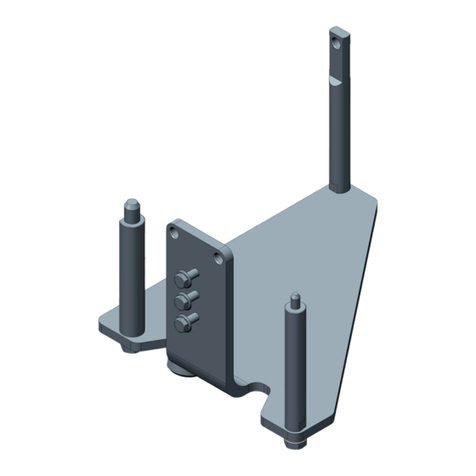
Bosch
Bosch T10483 User manual
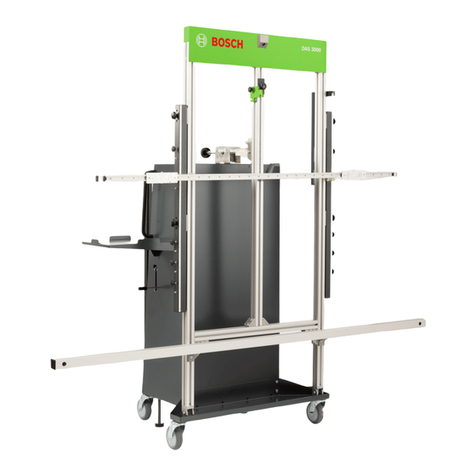
Bosch
Bosch DAS 3000 User manual
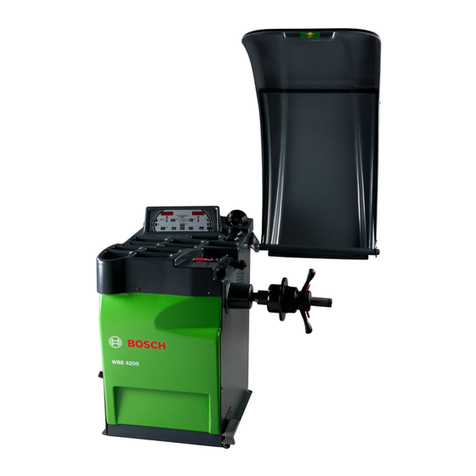
Bosch
Bosch WBE 4200 Setup guide
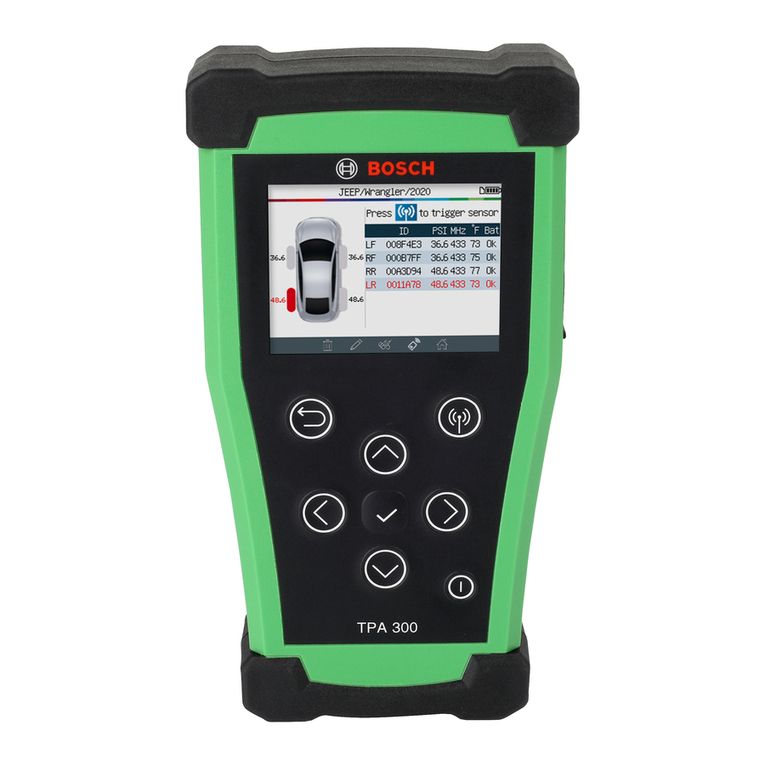
Bosch
Bosch TPA 300 User manual
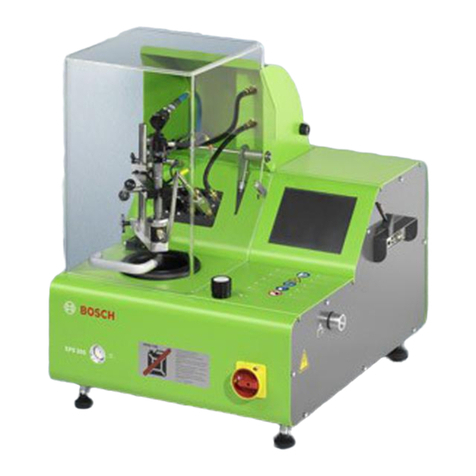
Bosch
Bosch 1 687 010 393 User manual

Bosch
Bosch DAS 3000 Setup guide
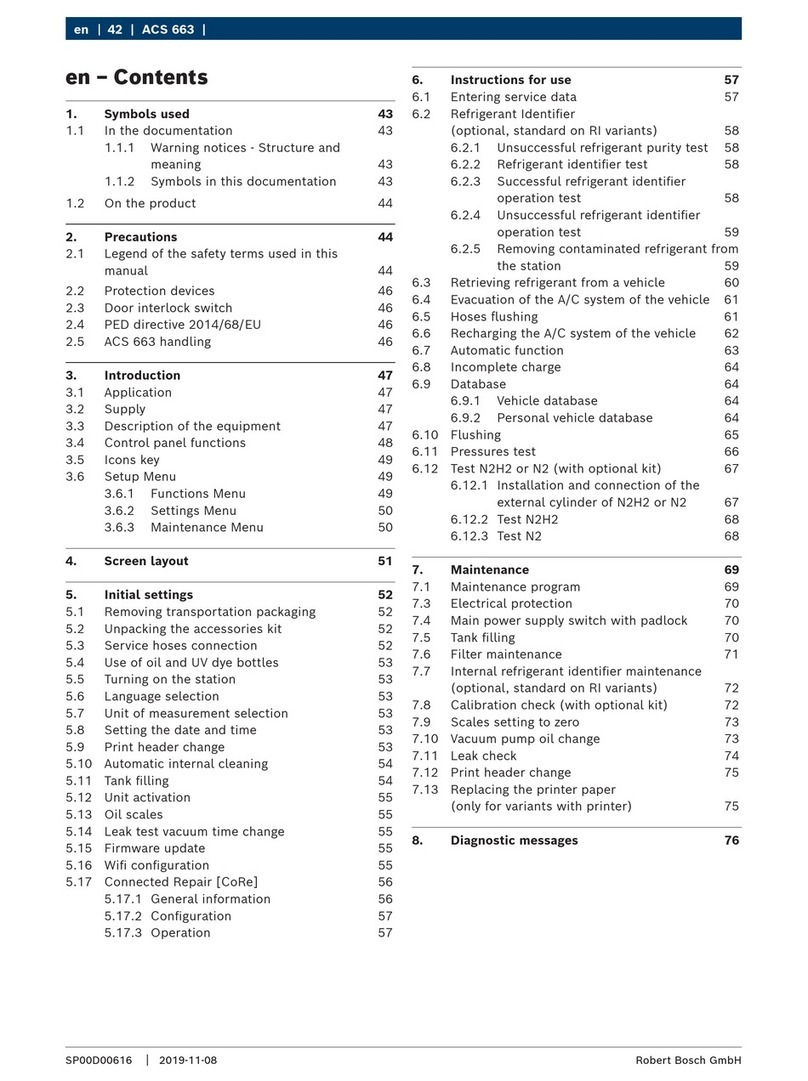
Bosch
Bosch ACS 663 User manual

Bosch
Bosch SCT 141 Series User manual
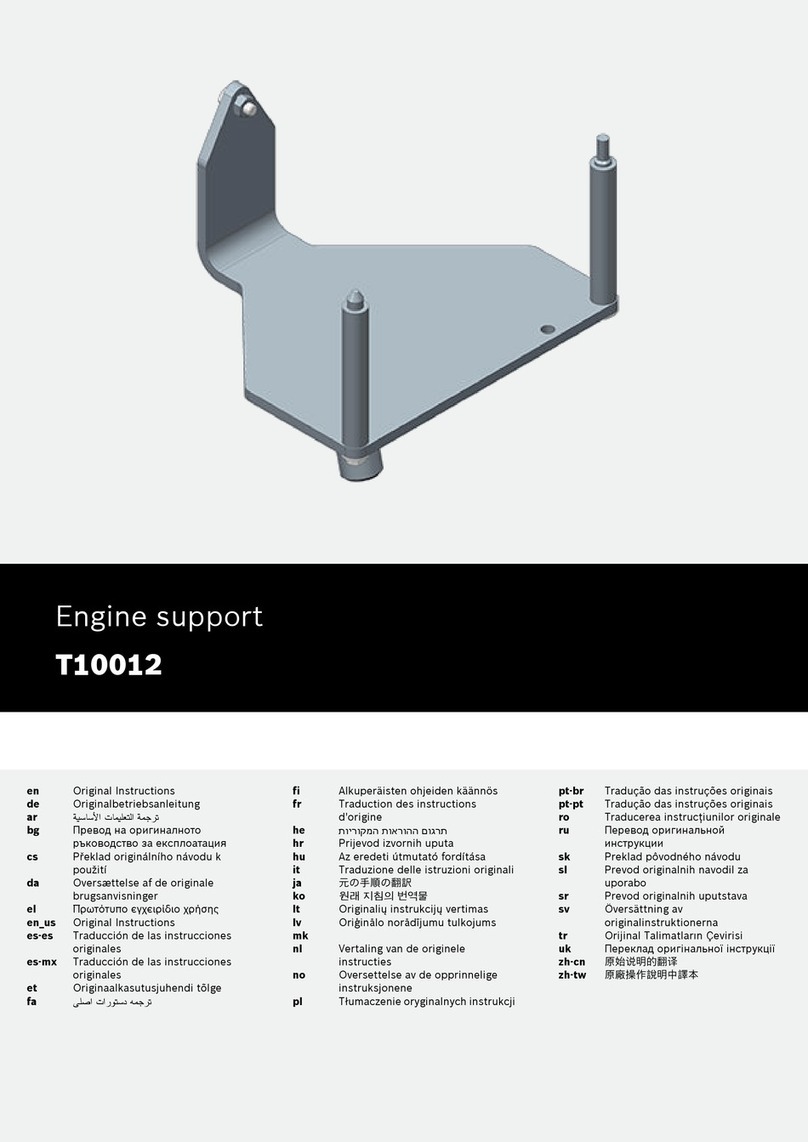
Bosch
Bosch T10012 User manual

Bosch
Bosch ACS 651 User manual

Bosch
Bosch ACS 652 Setup guide
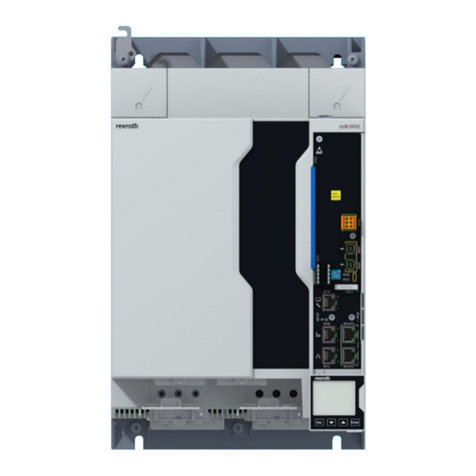
Bosch
Bosch rexroth ctrlX SAFETY SafeMotion Instructions for use

Bosch
Bosch T40075A User manual
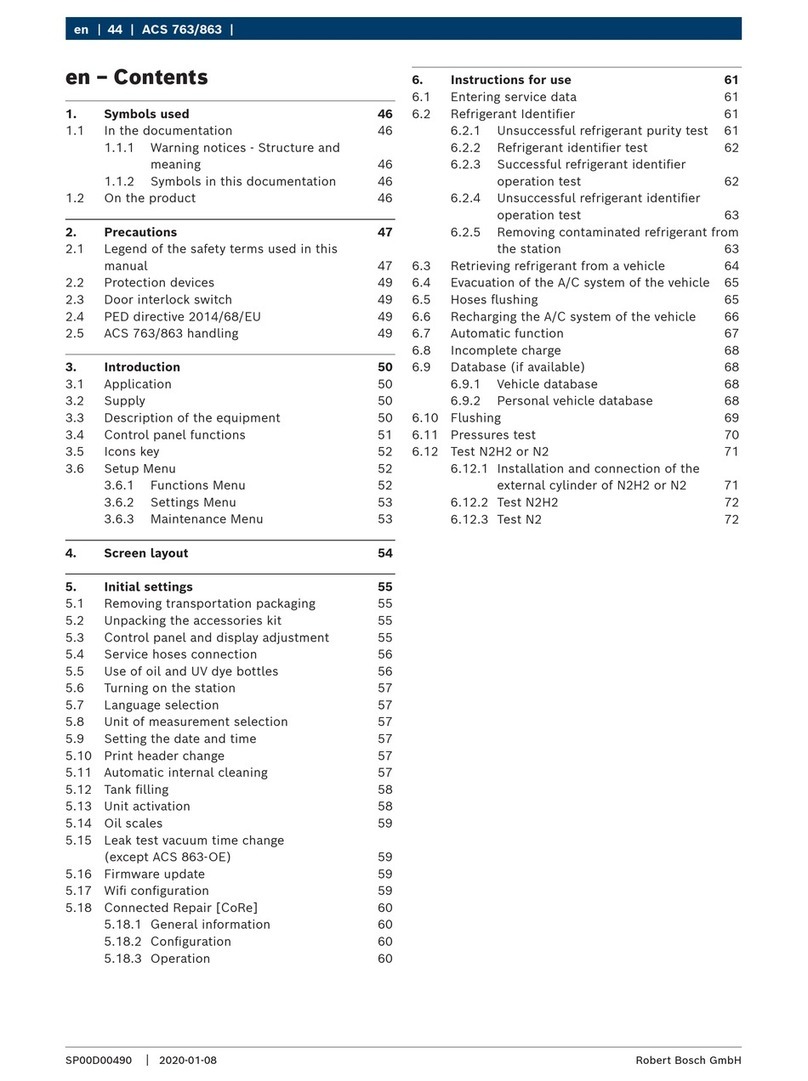
Bosch
Bosch ACS 763 User manual
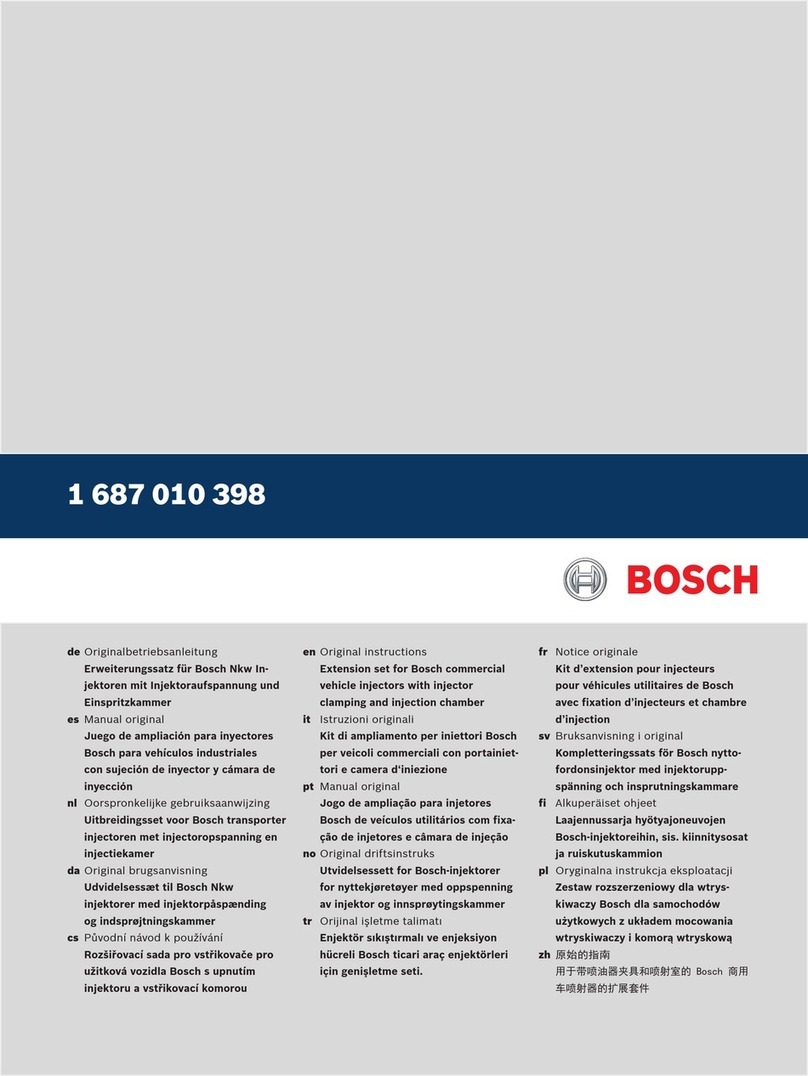
Bosch
Bosch 1 687 010 398 User manual
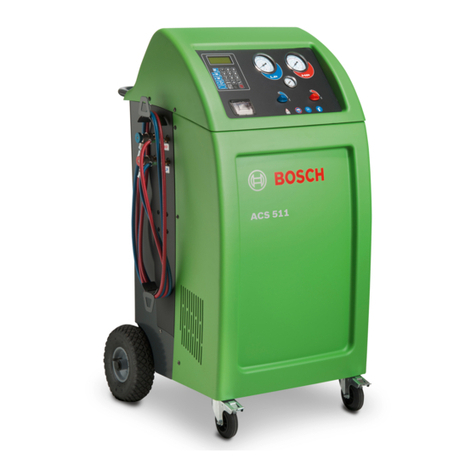
Bosch
Bosch ACS 511 Setup guide

Bosch
Bosch SCT 815 User manual
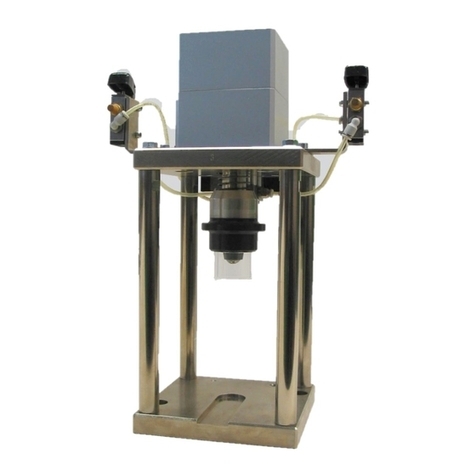
Bosch
Bosch CRR 130 User manual

Bosch
Bosch ACS 251 User manual
